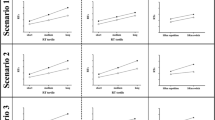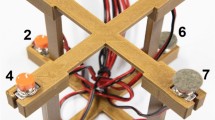Abstract
The spatial–numerical association of response codes (SNARC) effect showed that small/large numbers represented in the left/right space facilitated left/right responses, respectively. However, the processing stage (semantic representation or response selection) of the SNARC effect is still controversial. To investigate this issue, we adopted a modified magnitude comparison task in which the effects of SNARC, Stroop (semantic-representation stage), and Simon (response-selection stage) could be simultaneously induced. The processing stages of the SNARC effect were investigated by examining the interactions among these effects. According to the additive factor logic, if two effects are interactive, then they occur in the same stage; if two effects are additive, then they occur in different stages. Across two experiments, the SNARC effect interacted with the Stroop effect and with the Simon effect. These results suggested that the SNARC effect occurred in both the semantic-representation and response-selection stages and provided insight into that the SNARC effect might have two originating sources.



Similar content being viewed by others
Data availability
The anonymized data, stimuli, and preprocessing/analysis details are available upon request.
Abbreviations
- SNARC:
-
Spatial–numerical association of response codes
- SRC:
-
Stimulus–response compatible
- RT:
-
Response time
- ER:
-
Error rate
References
Abad, E. V., Scheffers, M. K., Coles, M. G. H., Fournier, L., & Adamson, A. (1997). The dimensionality of the flanker compatibility effect: a psychophysiological analysis. Psychological Research Psychologische Forschung, 60(3), 144–155.
Ansorge, U., & Wühr, P. (2004). A response-discrimination account of the Simon effect. Journal of Experimental Psychology: Human Perception and Performance, 30(2), 365.
Basso Moro, S., Dell’Acqua, R., & Cutini, S. (2018). The SNARC effect is not a unitary phenomenon. Psychonomic Bulletin & Review, 25(2), 688–695.
Chen, A., Bailey, K., Tiernan, B. N., & West, R. (2011). Neural correlates of stimulus and response interference in a 2–1 mapping stroop task. International Journal of Psychophysiology, 80, 129–138.
Cutini, S., Scarpa, F., Scatturin, P., DellAcqua, R., & Zorzi, M. (2014). Number-space interactions in the human parietal cortex: enlightening the SNARC effect with functional near-infrared spectroscopy. Cerebral Cortex, 24(2), 444–451.
Daar, M., & Pratt, J. (2008). Digits affect actions: the SNARC effect and response selection. Cortex, 44(4), 400–405.
De Jong, R., Liang, C. C., & Lauber, E. (1994). Conditional and unconditional automaticity: a dual-process model of effects of spatial stimulus–response correspondence. Journal of Experimental Psychology: Human Perception and Performance, 20(4), 731–750.
Dehaene, S., Bossini, S., & Giraux, P. (1993). The mental representation of parity and number magnitude. Journal of Experimental Psychology: General, 122(3), 371–396.
Egner, T. (2008). Multiple conflict-driven control mechanisms in the human brain. Trends in Cognitive Sciences, 12(10), 374–380.
Fischer, M. H., & Shaki, S. (2014). Spatial associations in numerical cognition–from single digits to arithmetic. Quarterly Journal of Experimental Psychology, 67(8), 1461–1483.
Fischer, M. H., Warlop, N., Hill, R. L., & Fias, W. (2004). Oculomotor bias induced by number perception. Experimental Psychology, 51(2), 91–97.
Fitousi, D., & Algom, D. (2020). A model for two-digit number processing based on a joint Garner and system factorial technology analysis. Journal of Experimental Psychology: General, 149(4), 676–700.
Gevers, W., Caessens, B., & Fias, W. (2005). Towards a common processing architecture underlying Simon and SNARC effects. European Journal of Cognitive Psychology, 17(5), 659–673.
Hock, H. S., & Egeth, H. (1970). Verbal interference with encoding in a perceptual classification task. Journal of Experimental Psychology, 83(2), 299–303.
Houwer, J. (2003). On the role of stimulus–response and stimulus–stimulus compatibility in the stroop effect. Memory & Cognition, 31(3), 353–359.
Keus, I. M., Jenks, K. M., & Schwarz, W. (2005). Psychophysiological evidence that the SNARC effect has its functional locus in a response-selection stage. Cognitive Brain Research, 24(1), 48–56.
Keus, I. M., & Schwarz, W. (2005). Searching for the functional locus of the SNARC effect: evidence for a response-related origin. Memory & Cognition, 33(4), 681–695.
Kornblum, H., & Osman, A. (1990). Dimensional overlap: cognitive basis for stimulus–response compatibility—a model and taxonomy. Psychological Review, 97(2), 253–270.
Kornblum, S. (1994). The way irrelevant dimensions are processed depends on what they overlap with: the case of Stroop- and Simon-like stimuli. Psychological Research Psychologische Forschung, 56(3), 130–135.
Kornblum, S., & Lee, J. W. (1995). Stimulus–response compatibility with relevant and irrelevant stimulus dimensions that do and do not overlap with the response. Journal of Experimental Psychology: Human Perception and Performance, 21(4), 855–875.
Leuthold, H. (2011). The Simon effect in cognitive electrophysiology: a short review. Acta Psychologica, 136(2), 203–211.
Li, Q., Nan, W., Wang, K., & Liu, X. (2014). Independent processing of stimulus-stimulus and stimulus-response conflicts. PLoS ONE, 9(2), e89249.
Liu, X., Park, Y., Gu, X., & Fan, J. (2010). Dimensional overlap accounts for independence and integration of stimulus–response compatibility effects. Attention, Perception, & Psychophysics, 72(6), 1710–1720.
MacLeod, C. M. (1991). Half a century of research on the Stroop effect: an integrative review. Psychological Bulletin, 109(2), 163–203.
Mapelli, D., Rusconi, E., & Umiltà, C. (2003). The SNARC effect: an instance of the Simon effect? Cognition, 88(3), B1–B10.
Melara, R. D., Wang, H., Vu, K. P., & Proctor, R. W. (2008). Attentional origins of the Simon effect: behavioral and electrophysiological evidence. Brain Research, 1215, 147–159.
Nuerk, H. C., Kaufmann, L., Zoppoth, S., & Willmes, K. (2004). On the development of the mental number line: more, less, or never holistic with increasing age? Developmental Psychology, 40(6), 1199–1211.
Nuerk, H. C., Weger, U., & Willmes, K. (2001). Decade breaks in the mental number line? Putting the tens and units back in different bins. Cognition, 82, B25–B33.
Nuerk, H. C., Weger, U., & Willmes, K. (2002). A unit-decade compatibility effect in German number words. Current Psychology Letterss: Behaviour, Brain and Cognition, 2, 19–38.
Rusconi, E., Turatto, M., & Umilta, C. (2007). Two orienting mechanisms in posterior parietal lobule: an rTMS study of the Simon and SNARC effects. Cognitive Neuropsychology, 24(4), 373–392.
Scerrati, E., Lugli, L., Nicoletti, R., & Umilta, C. (2017). Comparing Stroop-like and Simon effects on perceptual features. Scientific Reports, 7(1), 17815.
Shepard, R. N., & Metzler, J. (1971). Mental rotation of three-dimensional objects. Science, 171(3972), 701–703.
Simon, J. R., & Berbaum, K. (1990). Effect of conflicting cues on information processing: the ‘Stroop effect’ vs the ‘Simon effect.’ Acta Psychologica, 73(2), 159–170.
Sternberg, S. (1969). The discovery of processing stages extensions of Donders’ method. Acta Psychologica, 30, 276–315.
Tlauka, M. (2002). The processing of numbers in choice-reaction tasks. Australian Psychological Society, 54(2), 94–98.
Treccani, B., Milanese, N., & Umilta, C. (2010). Influence on Simon and SNARC effects of a nonspatial stimulus–response mapping: between-task logical recoding. Journal of Experimental Psychology: Human Perception and Performance, 36(5), 1239–1254.
van Dijck, J. P., & Doricchi, F. (2019). Multiple left-to-right spatial representations of number magnitudes? Evidence from left spatial neglect. Experimental Brain Research, 237(4), 1031–1043.
van Dijck, J. P., & Fias, W. (2011). A working memory account for spatial–numerical associations. Cognition, 119(1), 114–119.
van Veen, V., Cohen, J. D., Botvinick, M. M., Stenger, V. A., & Carter, C. S. (2001). Anterior cingulate cortex, conflict monitoring, and levels of processing. NeuroImage, 14(6), 1302–1308.
Wang, K., Li, Q., Zheng, Y., Wang, H., & Liu, X. (2014). Temporal and spectral profiles of stimulus–stimulus and stimulus–response conflict processing. NeuroImage, 89, 280–288.
Wascher, E., Schatz, U., Kuder, T., & Verleger, R. (2001). Validity and boundary conditions of automatic response activation in the Simon task. Journal of Experimental Psychology: Human Perception and Performance, 27(3), 731–751.
Wiegand, K., & Wascher, E. (2005). Dynamic aspects of stimulus–response correspondence: evidence for two mechanisms involved in the Simon effect. Journal of Experimental Psychology: Human Perception and Performance, 31(3), 453–464.
Wiegand, K., & Wascher, E. (2007a). Response coding in the Simon task. Psychological Research Psychologische Forschung, 71(4), 401–410.
Wiegand, K., & Wascher, E. (2007b). The Simon effect for vertical S-R relations: changing the mechanism by randomly varying the S–R mapping rule? Psychological Research Psychologische Forschung, 71(2), 219–233.
Yan, L., Yang, G., Nan, W., Liu, X., & Fu, S. (2021). The SNARC effect occurs in the response-selection stage. Acta Psychol (Amst), 215. https://doi.org/10.1016/j.actpsy.2021.103292.
Yang, G., Nan, W., Li, Q., & Liu, X. (2015). Behavioral and electrophysiological profiles reveal domain-specific conflict processing. Advances in Computational Psychophysiology, 350(6256), 33–34.
Yang, G., Nan, W., Zheng, Y., Wu, H., Li, Q., & Liu, X. (2017). Distinct cognitive control mechanisms as revealed by modality-specific conflict adaptation effects. Journal of Experimental Psychology: Human Perception and Performance, 43(4), 807–818.
Zhang, H. H., Zhang, J., & Kornblum, S. (1999). A parallel distributed processing model of stimulus-stimulus and stimulus-response compatibility. Cognitive Psychology, 38(3), 386–432.
Zhou, X., Chen, C., Chen, L., & Dong, Q. (2008). Holistic or compositional representation of two-digit numbers? Evidence from the distance, magnitude, and SNARC effects in a number-matching task. Cognition, 106(3), 1525–1536.
Zohar-Shai, B., Tzelgov, J., Karni, A., & Rubinsten, O. (2017). It does exist! A left-to-right spatial–numerical association of response codes (SNARC) effect among native Hebrew speakers. Journal of Experimental Psychology: Human Perception and Performance, 43(4), 719–728.
Funding
This work was supported by grants from the National Natural Science Foundation of China (31571161, 31970993), the German Research Foundation (DFG) (NSFC 62061136001/DFG TRR-169), the China Scholarship Council, the Philosophy and Social Sciences Co-construction Project in Guangdong Province of China (GD17XXL03), and the Youth Project of Humanities and Social Sciences by Ministry of Education in China (19YJC190017).
Author information
Authors and Affiliations
Contributions
This study was designed by WZ, XL, and YL. WN and YL created the stimuli. WN and YL programmed the experiment. WN and YL oversaw the data collection and analyzed the data. WN, XL, SF, GY, and YL wrote the manuscript.
Corresponding authors
Ethics declarations
Conflict of interest
All authors declare that they has no conflict of interest.
Ethical approval
This study was approved by the Institutional Review Board of the Educational School, Guangzhou University. All procedures performed in studies involving human participants were in accordance with the ethical standards of the institutional and national research committee and with the 1964 Helsinki Declaration and its later amendments or comparable ethical standards.
Informed consent
Informed consent was obtained from all individual participants included in the study.
Additional information
Publisher's Note
Springer Nature remains neutral with regard to jurisdictional claims in published maps and institutional affiliations.
Rights and permissions
About this article
Cite this article
Nan, W., Yan, L., Yang, G. et al. Two processing stages of the SNARC effect. Psychological Research 86, 375–385 (2022). https://doi.org/10.1007/s00426-021-01506-5
Received:
Accepted:
Published:
Issue Date:
DOI: https://doi.org/10.1007/s00426-021-01506-5




